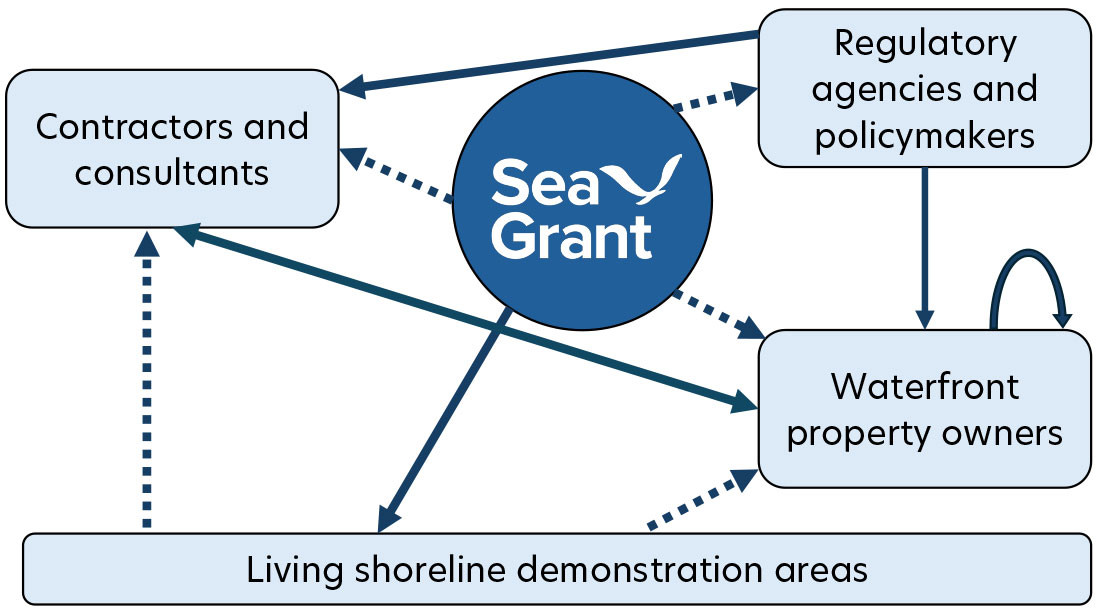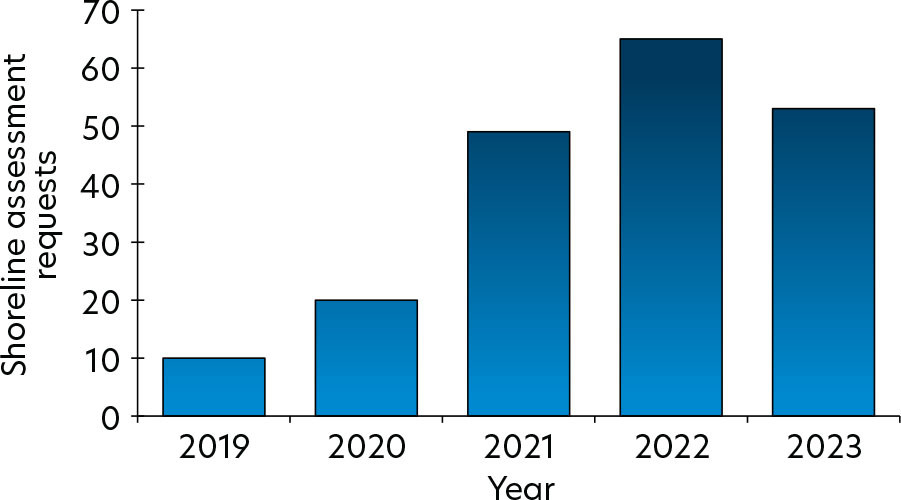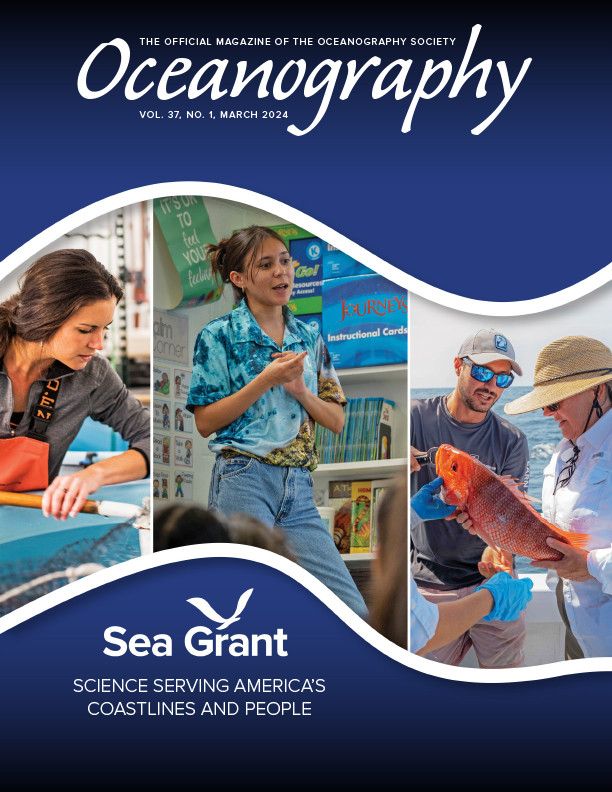Relevance
As people continue to move to the coast, shorelines are increasingly threatened by development and other human activity. Combined with storms and sea level rise, these pressures have contributed to the loss of over 257,000 acres (1,040 km2) of wetlands along the northern Gulf of Mexico between 2004 and 2009 (Dahl, 2011), leading to the deterioration of ecosystem services such as wildlife habitat, water filtration, and storm amelioration. To prevent this loss, coastal property owners historically relied on hardened structures (i.e., bulkheads and seawalls). However, these structures cause environmental harm while only temporarily preventing erosion. Their installation requires the destruction of important intertidal habitats, they increase erosion on neighboring properties, and they often fail within 30 years or less, requiring maintenance or replacement (Nordstrom et al., 2009; Dugan et al., 2018).
Living shorelines, a method of using native marsh plants, sometimes combined with nearshore rock or oyster shell structures, to stabilize shorelines, is a more environmentally friendly and cost-effective alternative to hardened shorelines. While living shorelines prevent erosion, they also reintroduce or preserve ecosystem services (Davis et al., 2015; Sparks et al., 2015; Gittman et al., 2016; Figure 1). Additionally, they are often less expensive to implement than hardened structures, require less maintenance, and can self-maintain and adapt to changing environmental circumstances over time (Mississippi-Alabama Sea Grant Consortium, 2022). Despite these benefits, there are barriers that prevent living shorelines from being implemented across coastal Mississippi, Alabama, and Florida. These barriers primarily include a lack of knowledge among private property owners, a shortage of qualified contractors to install living shoreline projects, a difficult regulatory landscape, and a shortage of living shoreline resources.

FIGURE 1. A Biloxi, Mississippi, site is shown before (2018) and after (2021) installation of a living shoreline. Photo Credit: Eric Sparks. > High res figure
|
Sea Grant programs are uniquely positioned to address these barriers, because they often act as bridges between scientists, coastal decision-makers, and other stakeholders to create meaningful change in our coastal communities. In this case, connecting science, policy, practitioners, and property owners is essential to increasing the use of living shorelines (Figure 2). This article reviews the living shoreline work recently undertaken by Florida Sea Grant (FSG) and the Mississippi-Alabama Sea Grant Consortium (MASGC), the results that have been achieved, and the path forward for living shorelines across coastal Mississippi, Alabama, and Florida.

FIGURE 2. How Sea Grant interacts with key aspects of living shoreline systems. Solid lines represent direct influences (e.g., contractual relationships or policy decisions) that can determine whether or not a living shoreline is constructed. Dashed lines represent indirect effects (e.g., education and training) that can increase the likelihood of living shorelines implementation. > High res figure
|
Response
To expand the use of living shorelines across coastal Mississippi, Alabama, and Florida, FSG and MASGC have focused their living shoreline outreach on two relevant stakeholder groups: marine contractors and private property owners. An array of workshops, publications, and other efforts have been aimed specifically at engaging these two key stakeholder groups.
Marine Contractors
A main barrier to living shoreline implementation is the lack of qualified installers for such projects. Marine contractors in Mississippi, Alabama, and Florida have traditionally built bulkheads, seawalls, and other types of shoreline armoring. Many were unaware of living shorelines as an option for shoreline stabilization or lacked the expertise required to construct coastal habitats and navigate the permitting process. To address this, both FSG and MASGC have hosted workshops and developed contractor-specific resources to engage with these key private sector stakeholders.
The MASGC Living Shoreline Program hosted workshops specifically for marine contractors between 2019 and 2022. These workshops covered living shoreline basics, important design considerations, permitting and regulations, and local examples of living shorelines. Following these trainings, MASGC provides assistance to the contractors as requested, including performing site visits with the contractors, helping them to answer property owner questions, and walking through shoreline designs. To further help educate marine contractors, MASGC also produced a wide array of contractor-specific living shoreline resources. Examples include state-specific permitting guides to facilitate permitting, property owner questionnaires that contractors can use to gather valuable information for living shoreline designs, plant guides that provide tips on which native plants to use in a living shoreline, and more. These can be found at https://masgc.org/living-shorelines/contractor-resources.
FSG living shoreline program staff have led the way when it comes to engaging with contractors. They collaborated with multiple agencies and nongovernmental organizations to develop and deliver living shoreline workshops such as the Florida Living Shorelines Training for Marine Contractors, Living Shoreline Permitting Workshops, and the Panhandle Regional Living Shoreline Summit.
By engaging with, educating, and creating contractor-specific resources, FSG and MASGC continue to work towards building a qualified field of installers for living shorelines across the three states.
Private Property Owners
Private property owners are arguably the most important stakeholder group for living shoreline outreach. While large-scale living shoreline projects are typically installed on public lands, most coastal property is privately owned. Therefore, private property owners are key to increasing the use of living shorelines. Common barriers that prevent private property owners from installing living shorelines include lack of knowledge and uncertainty about where to turn to for help. FSG and MASGC have worked extensively with private property owners to reduce these barriers.
MASGC has hosted property owner workshops across Mississippi and Alabama. In these workshops, property owners learned what a living shoreline is, how it could benefit their properties, and how living shoreline project costs compare to traditional shoreline hardening, and they were introduced to the MASGC Living Shoreline Technical Assistance Program. Through this program, MASGC provides free living shoreline assessment, design, and permitting services to private property owners. Furthermore, MASGC has produced state-specific permitting guides for property owners and a number of easy-to-understand living shoreline fact sheets. These are also housed on https://masgc.org/living-shorelines/contractor-resources.
FSG has similarly focused on education for private property owners in Florida. A series of publications designed to teach property owners to navigate the living shoreline permitting process was published by FSG in 2019 and continues to be updated as regulations change. Additionally, many FSG agents engage individually with homeowners and homeowners’ associations by conducting site visits to assess properties for living shoreline suitability. FSG has also been actively pursuing efforts that increase general awareness of living shorelines that have directly and indirectly led to more engagement with private property owners. For example, FSG contributes to the content and maintenance of the popular https://floridalivingshorelines.com/ website, a collaborative repository for resources such as plant lists, a trained contractor database, and a database of living shoreline demonstration projects. FSG also developed the curriculum for and frequently offers the three-day Coastal Shoreline Restoration module of the Florida Master Naturalist Program (FMNP CSR), which teaches participants about each of the core habitats that go into living shoreline construction (marshes, mangroves, and oyster reefs) and how to restore them in a living shorelines context. Finally, FSG has been increasing the visibility of living shorelines as an option for homeowners by building demonstration living shoreline projects that serve as educational destinations in communities throughout Florida. These efforts engage both public and private property owners as well as community members through volunteer events that are often well publicized.
Results
Mississippi and Alabama
Fifty-seven marine contractors attended workshops and trainings held by the MASGC Living Shoreline Program between 2019 and 2022. These workshops directly resulted in at least five contractors incorporating living shorelines into their businesses. However, most MASGC Living Shoreline Program efforts focused on private property owners. Over the four years of the program, more than 150 property owners have attended workshops or engaged with the program in another way. Of those property owners, at least 135 (87%) took the next step toward installing a living shoreline by requesting a free shoreline assessment from the program team. Furthermore, as the MASGC Living Shoreline Program has grown, the number of shoreline assessments increased each year with the exception of 2023 (Figure 3). In 2023, the State of Mississippi paused living shoreline permit applications for private property owners while the state-level permitting process was being revised. Thus, the 2023 numbers represent primarily Alabama assessments, while 2019–2022 includes both Mississippi and Alabama.

FIGURE 3. Graph shows the numbers of shoreline assessments requested by private property owners in coastal Mississippi and Alabama between 2019 and 2022. Due to a permitting pause in Mississippi in 2023, that year primarily includes Alabama only. > High res figure
|
Florida
Marine Contractor Trainings
The Florida Living Shorelines Training for Marine Contractors has been taught 10 times since the curriculum launched in 2019, with at least seven more courses planned through mid-2024. So far, 191 professionals have completed the two-day training and reported knowledge gain about living shorelines ranging from 10% to 30%. Based on course evaluations, 58% of attendees reported they would “definitely” or “likely” add living shorelines to their professional services. A half-day living shoreline permitting workshop was offered in seven locations around Florida and was attended by 113 professionals. Post-training follow-ups indicated a 19% increase in knowledge about permitting processes involved in living shorelines.
Private Property Owners
FSG has provided consultation for or has been directly involved in the installation of 27 living shoreline projects on privately owned sites. In addition, FSG online resources for property owners have had a broad reach. The permitting publication series for property owners has been downloaded 6,408 times since 2019. FSG has also contributed to the installation of 31 demonstration living shoreline projects across 13 Florida counties (https://bit.ly/FSG-demo-LS). At least five property owners have been inspired by these demonstration projects to consider a living shoreline. The https://floridalivingshorelines.com/ website has had nearly 50,000 unique users since its launch, with about 10,000 of those being repeat users. The FMNP CSR course has been offered 35 times to a total of 593 participants in 16 Florida counties. Pre- and post-assessments from the course have shown an average knowledge gain of 46% about living shorelines and coastal habitats as a result of the course. As an example of the broad reach that demonstration projects can have, a series of three demonstration projects in Cedar Key, Florida, have been used to educate 1,419 people about living shorelines directly (i.e., in-person or via webinar), and an additional 125,821 through publications and social media posts from 2020-2023.
Results Summary
Interest in living shorelines across Mississippi, Alabama, and Florida has increased each year since the establishment of the MASGC and FSG living shoreline programs. These programs combined have engaged with over 361 marine contractors/professionals and 177 private property owners, supplemented by engagement with a large general public audience (2,012 direct contacts, 56,408 electronic contacts). Marine contractors and private property owners are essential to increasing the adoption of living shorelines. The workshops, training, and publications produced by these living shoreline programs have decreased barriers related to knowledge and resources for living shoreline implementation across the three states. However, the FSG and MASGC living shoreline programs recognize that there is more work to do and that other barriers remain.
Moving Living Shorelines Forward in Coastal Mississippi, Alabama, and Florida
While great strides have been made to expand the use of living shorelines across our three states, the respective Sea Grant living shoreline programs have identified remaining barriers that can be grouped into two categories: regional permitting challenges and living shoreline resource limitations.
Regional Permitting Challenges
Ideally, private property owners would be granted permits for living shorelines under simplified regulations (i.e., the Mississippi and Alabama Living Shoreline General Permits and the Florida Living Shoreline Permit Exemption). However, permitting challenges in the region generally include restrictions on living shoreline design that can push these projects into more complicated permitting scenarios, increase their cost, and hamper their effectiveness.
First, all three states require at least some planting on a living shoreline. While native marsh plantings are generally considered to be an essential part of a living shoreline design, it is not necessarily the best practice at all sites. In some high-wave-energy environments where there is an existing marsh, planting may not be necessary. However, some sort of wave break is needed to protect what is already there from boat wakes. Current permitting regulations do not allow this kind of living shoreline, leaving property owners to either consider alternatives to living shorelines (i.e., a bulkhead) or to spend additional funds on shoreline plantings that are unlikely to survive. By allowing nearshore protection in a design, with no associated plantings, the project costs would be lowered, the permitting process would be easier, and property owners would be more incentivized to choose a living shoreline over armoring.
Second, regulatory agencies do not generally allow any impacts to submerged aquatic vegetation (SAV) under the simplest living shoreline permit types, no matter how minor. A common situation across the three states is that as vegetated shorelines erode and, as native marsh grasses are lost, SAV expands into that area. Though SAV is an important habitat, often restoring the shoreline to prevent further erosion would mean impacting narrow bands of this SAV and pushing the project into more complex and often costly permitting, if it were allowed at all. Allowing very minor impacts to SAV below a predefined threshold in cases of the restoration of previously existing native marsh would keep permitting costs down, speed up the permitting process, and again, incentivize these kinds of projects for property owners.
Third, current regulations limit the height of breakwaters to one foot (0.3 m) above (Mississippi, Alabama) or not higher than (Florida) mean high water, and the distance from mean high water that living shoreline features can be installed is limited to 35 ft (10.7 m) in Mississippi, 30 ft (9.1 m) in Alabama, and 10 ft (3.0 m) in Florida (Barry et al., 2019; USACE, 2021, 2023). However, these limits only consider current conditions and not future changes. It is widely accepted that the rates of sea level rise in the Gulf of Mexico are higher than the global average (Dangendorf et al., 2023). Living shoreline projects should be planned in a way that allows for adaptation to future sea levels, but current regulations do not incentivize or even allow this type of planning. If breakwaters were allowed to be constructed farther from shore (in Florida) at a higher crest height, or if planned increases in crest height could be implemented without a new permit, it would enhance living shoreline effectiveness further into the future and reduce necessary maintenance. In turn, this would reduce project costs and provide yet another incentive for property owners to choose a living shoreline over traditional hardening.
By addressing regulatory barriers, more living shoreline projects would fall under the Mississippi and Alabama Living Shoreline General Permits and the Florida Living Shoreline Permit Exemption, and permitting a living shoreline project in the region would be simplified, cost less, and be more appealing to property owners.
Living Shoreline Resource Limitations
The lack of living shoreline resources often limits the appeal and feasibility of living shorelines for property owners. For those who are still unsure about a living shoreline as a viable option at their property, demonstration sites can be helpful. Despite progress on demonstration sites, especially in Florida, there are still large areas of each of our states in which such sites are not easily accessible. By increasing the number of demonstration sites and providing details about their construction, costs, and performance, hesitant property owners can have their concerns eased and be inspired.
Native marsh plants are among the most important elements in a living shoreline design. However, across the three states, very few nurseries grow and sell these plants. Because of this scarcity, living shoreline installation can be delayed, which may deter property owners concerned about erosion, especially in areas vulnerable to summer boat traffic or hurricanes. The establishment of more native plant nurseries in this region would help to meet the growing demand for living shorelines.
Finally, as interest in living shorelines grows, the need for free or lower-cost technical assistance also increases. Property owners do not necessarily have the expertise needed or want to be responsible for all aspects of the design, permitting, and installation of a living shoreline project. Programs that provide these services are invaluable in increasing the use of living shorelines across the region. However, programs like these that can act as a one-stop shop for property owners take time, experience, and knowledge to develop.
With the technical expertise, ability to translate science-based information, and community-embedded personnel, Sea Grant is well suited to facilitate expansion of living shorelines. As with what is presented here for FSG and MASGC, Sea Grant staff can act as a bridge between living shoreline researchers, permitting agencies, marine contractors, and property owners to address barriers to living shoreline implementation, work with regulatory agencies to simplify the permitting process, and increase resources.
Acknowledgments
We would like to acknowledge Annie Roddenberry and all contributing partners of floridalivingshorelines.com, Marty Main and the Florida Master Naturalist Program, Fara Ilami and co-authors of the Florida Living Shorelines Training for Marine Contractors curriculum, and the members of the MASGC Living Shorelines and Mississippi State University Coastal Conservation and Restoration Programs for their contributions to this work. Additionally, partial funding for the work highlighted here was provided by the NOAA Sea Grant College Program across both the Florida Sea Grant and Mississippi-Alabama Sea Grant Omnibus funding (NA18OAR4170085,NA22OAR4170091, NA18OAR4170080, and NA22OAR4170090), NOAA Coastal Zone Management Program (NA20NOS4190109), Florida Department of Environmental Protection (NS093 and R1819), US Environmental Protection Agency Gulf of Mexico Program (00D86319), Florida Fish and Wildlife Conservation Commission State Wildlife Grant (19004), the Gulf of Mexico Alliance Gulf Star Program (GSC-122234), the Mississippi Department of Marine Resources Tidelands Trust Fund Program (FY20-M500-05), and the USDA Natural Resources Conservation Service (NR224423XXXXC094).




